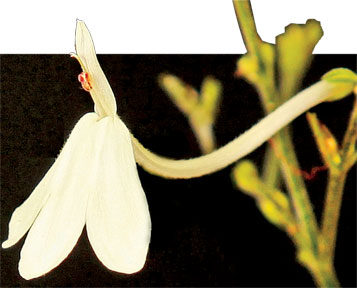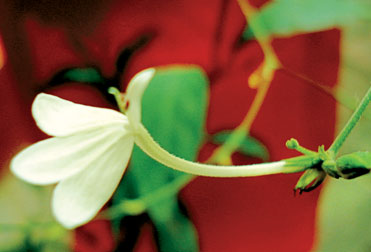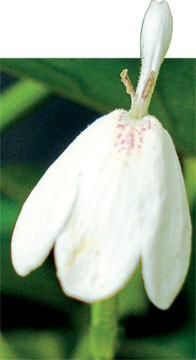|
Remarkable discovery by team of scientists:
Sri Lanka abounds with rare flora
By Dhaneshi YATAWARA
Sri Lanka stands unique among the biodiversity hotspots of the world.
A remarkably high number of endemic species is found among our fauna and
flora with around 23 percent of the flowering plants being endemic. Sri
Lanka is home for about 3,360 flowering plant species belonging to 200
plant families. The low country wet zone and mountainous areas in the
South West harbour 90 percent of our endemic species.
 |
|
Rhinacanthus
polonnaruwensis |
|
The new plant

Rhinocanthus flavovirens
*20 – 80 cm tall
*Yellowish green flowers
*Semi-erect branches
* Herb
*Oval elliptic to oblong elliptic shaped leaves
*Flower tube 34 – 37 mm long
*The flower tube has a purple base
*The flower tube is continuously curved, reaches upwards, towards the
mouth of the flower |
Scientists believe that a significant proportion of our plant genome
could remain unknown, even at present. This doubt leads many scientists
at all levels to explore the massive floral kingdom of Sri Lanka.
Many discover new properties of plants, be it medicinal or
industrial, but a plant totally new to the world would stand out in
history.
Such a remarkable discovery was made last year by a team of
scientists which included a budding researcher who had graduated in
agriculture and a veteran botanist.
A new species of 'Aniththa', a valuable medicinal plant, was
discovered by Prabha Amarasinghe and Dr. Siril Wijesundara and was named
Rhinacanthus flavovirens . All variants of these plants are known as
Aniththa in Sinhala and Nagamulli in Tamil. In English it is known as
white crane flower.
According to Amarasinghe, only two species in the genus Rhinacanthus
has previously been recorded in Sri Lanka – i.e. Rhinacanthus nasutus
named by German botanist Wilhelm Sulpiz Kurz and 'Rhinacanthus
polonnaruwensis' by botanist L.H.Cramer described in 1998.
“In Sri Lanka this plant Aniththa is only used for skin ailments.
Distinctive features were seen in the different plants, but all were
known by one name in indigenous medicine. The Bandaranaike Memorial
Ayurvedic Research Institute wanted to find out whether there are
different medicinal properties specific to these variations of Aniththa
plants – among the already known varieties,” she explained. This was the
starting point for her research as her final year thesis in 2008 and
examining the two species that existed revealed the existence of a new
species.
Rhinacanthus nasutus Kurz and Rhinacanthus polonnaruwensis Cramer are
medicinal plant species of Sri Lanka belonging to the plant family
Acanthaceae with anti-fungal, anti-bacterial, anti-viral, anti-pyretic
and anti-cancer properties. Specimens from seven districts of Sri Lanka
were studied for morphological characters. A data matrix with 50
quantitative characters of 111 specimens was derived from the basic data
matrix with 88 characters of 122 specimens after eliminating discrete,
missing and overlapping data.
The new plant
“I found the new variation and only after I graduated did I start my
research to fully describe this new species,” she said. As she
discovered, it is the floral patterns that are mostly distinctive in
differentiating the three plants.
 |
|
Rhinocanthus
flavovirens |
The new species is a perennial herb (a plant that lives for more than
two years) which grows up to 20 – 80 centimetres high. Leaves are
elliptic – either oval or oblong. Purple marks can be seen in the lower
lip of the flower of the R. Nasutus and the corolla tube is straight. R.
Nasutus is a woody shrub.
The corolla (petal) of the flower is yellowish green, thus comes the
name ‘flavovirens’ which in Latin means yellowish green, according to
Amarasinghe. The difference is in the tube that fixes the flower to the
branch. In the new variety it is strongly curved. In R. Polonnaruwensis
it is almost like a slightly curved 'S'. “The new variety I found in the
North Central Province can be found in the dry lowlands of the country,”
she said. Unable to find fully grown plants widely available naturally,
she examined the specimens available with the Nawinna Ayurvedic Research
Institute in Maharagama. “I could confirm that this was a new plant,”
she said.
Low availability
During her three-year research, Amarasinghe found that these plants
are not abundant. “If we don't take proper steps to conserve these
plants, it may seem highly likely that they become a threatened plant
species,” she said. Though indigenous medicine uses Aniththa mainly for
skin ailments, in many countries research has already begun on its
anti-cancer properties, according to Amarasinghe. R. Polonnaruwensis is
categorised as endangered.
The next step of the scientists was to compare them with the
specimens available at Kew Gardens, England where almost all the plants
of the genus 'Rhinacanthus' collected from all over the world were
preserved. The scientists had compared specimen plants of the same
variety, called Rhinocanthus dichotomous, from coastal Kenya and
Tanzania to which the newly discovered plant was morphologically most
similar. “The samples those botanists sent closely resembled the
Rhinacanthus flavovirens but it clearly showed microscopic differences
and the doubts were cleared,” she said.
Variations
 |
|
Rhinacanthus nasutus |
Researchers have found four morphological variations at the initial
stage of their research belonging to R. Nasutus, R. flavovirens and two
groups for R. polonnaruwensis. The first two are explained above and the
two varieties found in the R. polonnaruwensis, corresponding to material
collected from the wet and dry zones, showed differences.
The plant from
the wet zone had a less hairy stem, shorter leaves and several other
differences to that from the dry zone. “These different morphological
characters which may simply be ecological adaptations, were not
significant enough to place them in separate groups," she said.
According to Amarasinghe the newly discovered plants were thinly
distributed in North Central, Central and Southern Provinces in lowland
secondary forests.
“This is the first new species I revealed and it is very encouraging
to have a veteran botanist such as Dr. Siril Wijesundara support and
guide me in this endeavour,” the budding botanist expressed her
gratitude. “These days I'm studying for my Master's Degree and I
continue to experiment on these plants and microscopically examine their
medicinal properties. This is expensive research, but is gaining
support.
We may able to see promising results in the future,” she said
with bright hopes for a greener future for this valuable research.
|

